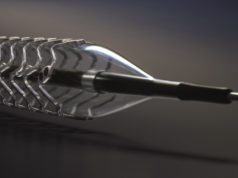 Transcatheter aortic valve implantation (TAVI) pioneer and principal investigator of the SURTAVI trial, Michael Reardon (professor of cardiovascular surgery, Academic Institute Methodist DeBakey Heart & Vascular Center, Houston, USA), discusses the five-year clinical and echocardiographic outcome data from the study, recently presented at the Transcatheter Cardiovascular Therapeutics annual meeting (TCT 2021; 4–6 November, Orlando USA and virtual).
Transcatheter aortic valve implantation (TAVI) pioneer and principal investigator of the SURTAVI trial, Michael Reardon (professor of cardiovascular surgery, Academic Institute Methodist DeBakey Heart & Vascular Center, Houston, USA), discusses the five-year clinical and echocardiographic outcome data from the study, recently presented at the Transcatheter Cardiovascular Therapeutics annual meeting (TCT 2021; 4–6 November, Orlando USA and virtual).
The data comparing TAVI using an early-generation device to surgical aortic valve replacement (SAVR) show no difference in all-cause mortality or stroke between the two procedures. These findings are reassuring and important, Reardon tells Cardiovascular News.
How significant are these data and should they change the approach to treating patients at moderate surgical risk?
As we move to younger and lower risk patients, we are concerned about the durability of the valves we use. Although only mid-term data, the early excellent outcomes of the CoreValve/Evolut (Medtronic) TAVI system when compared directly with surgery is maintained without any decrement. This is important and reassuring.
The study showed that initially, there were more reinterventions after TAVI, though this levelled out between three to five years. How do you account for this finding and should this influence treatment choices?
This trial was 83% first-generation CoreValve and 17% second-generation Evolut R. There were no third-generation current use Evolut Pro valves used at all. First generation valves had early issues with paravalvular leak (PVL) and sometimes had another catheter procedure to fix this. Most were early. The fact that this matched surgery in years three to five is very reassuring that this is not an ongoing issue with time. Many of these early issues have been addressed with the current generation valve.
Surgery held the advantage versus TAVI in terms of PVL—is this an important finding?
This is important and seen in all randomised TAVI trials so far. Almost all TAVI valves in this trial were first generation. Third generation valve with a pericardial sealing skirt were not available and have significantly improved this for TAVI.
What are the important questions that still need to be answered around TAVI in younger patients, and what are the next steps for the SURTAVI trial?
We still need 10-year data for durability of outcomes and valve performance. SURTAVI has been changed from a five-year follow-up study to a 10 year follow up study to address this.
What important takeaway message do you take from the five-year SURTAVI data?
The clinical outcomes and valve performance in the SURTAVI trial have both been shown to be very durable to five years. TAVI has superior haemodynamic performance to surgery at all times points and is very durable.













